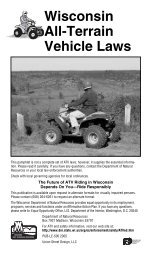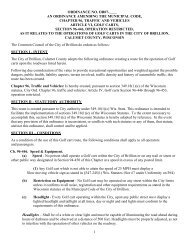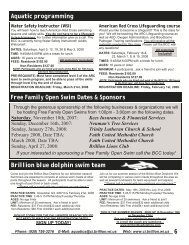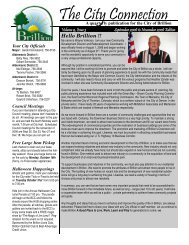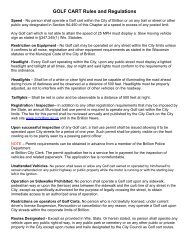Streets, Sidewalks and Other Public Places - City of Brillion
Streets, Sidewalks and Other Public Places - City of Brillion
Streets, Sidewalks and Other Public Places - City of Brillion
You also want an ePaper? Increase the reach of your titles
YUMPU automatically turns print PDFs into web optimized ePapers that Google loves.
Chapter 82 STREETS, SIDEWALKS AND OTHER PUBLIC PLACES*__________*Cross references: The establishment <strong>of</strong> grades, curblines <strong>and</strong> widths <strong>of</strong> sidewalks in thepublic streets <strong>and</strong> alleys saved from repeal, § 1-10(2); the lighting <strong>of</strong> streets <strong>and</strong> alleys savedfrom repeal, § 1-10(5); the naming <strong>and</strong> changing <strong>of</strong> names <strong>of</strong> streets, alleys, public grounds<strong>and</strong> parks saved from repeal, § 1-10(7); construction <strong>of</strong> any public works saved from repeal, §1-10(12); consumption or possession <strong>of</strong> intoxicants on streets, § 6-94; buildings <strong>and</strong> buildingregulations, ch. 14; moving buildings, § 14-171 et seq.; cemeteries, ch. 22; library, ch. 50;mobile homes, ch. 54; parks <strong>and</strong> recreation, ch. 62; planning, ch. 66; subdivisions, ch. 86;traffic <strong>and</strong> vehicles, ch. 94; utilities, ch. 98; vegetation, ch. 102; zoning, ch. 106.State law references: Authority regarding streets <strong>and</strong> sidewalks generally, Wis. Stats. §§62.16, 66.615.__________Article I. In GeneralSec. 82-1. Board <strong>of</strong> public works, rules <strong>and</strong> regulations.Sec. 82-2. Grades.Sec. 82-3. Construction <strong>and</strong> repair.Sec. 82-4. Curbs <strong>and</strong> gutters.Sec. 82-5. Obstructions <strong>and</strong> encroachments.Sec. 82-6. Excavations.Sec. 82-7. Street privilege permit.Sec. 82-8. Terrace areas.Sec. 82-9. Street numbers.Sec. 82-10. Requests for improvements.Sec. 82-11. Unlawful dumping on streets.Sec. 82-12. Obstruction <strong>of</strong> public ditches.Secs. 82-13--82-32. Reserved.Article II. <strong>Sidewalks</strong>Sec. 82-33. Snow <strong>and</strong> ice removal.Sec. 82-34. Construction <strong>and</strong> repair.Sec. 82-35. New subdivisions.Sec. 82-36. <strong>Sidewalks</strong> in culs-de-sac.Sec. 82-37. Grade <strong>and</strong> width.Sec. 82-38. Specifications.Sec. 82-39. When repair required.Sec. 82-40. Illegal sidewalks.Sec. 82-41. Removal <strong>of</strong> rubbish <strong>and</strong> dirt from sidewalks.ARTICLE I. IN GENERALSec. 82-1. Board <strong>of</strong> public works, rules <strong>and</strong> regulations.In addition to the rules <strong>and</strong> regulations contained in this chapter for the construction,use <strong>and</strong> repair <strong>of</strong> streets, alleys, sidewalks <strong>and</strong> public places, the board <strong>of</strong> public works mayprepare, promulgate <strong>and</strong> enforce such other rules, regulations <strong>and</strong> conditions, not inconsistentwith this chapter, as may be deemed useful for the preservation <strong>of</strong> streets, alleys, sidewalks<strong>and</strong> public places.(Code 1983, § 8.01)
Cross references: Administration, ch. 2.State law references: Board <strong>of</strong> public works generally, Wis. Stats. § 62.14; public works,contracts, bids generally, Wis. Stats. § 66.29.Sec. 82-2. Grades.The city engineer shall establish the grades <strong>of</strong> all streets <strong>and</strong> alleys in the city, <strong>and</strong>such grades shall be recorded in the <strong>of</strong>fice <strong>of</strong> the city clerk/treasurer. No street or alley shall beworked until its grade is established, described <strong>and</strong> recorded in the clerk/treasurer's <strong>of</strong>fice.(Code 1983, § 8.02(1))Sec. 82-3. Construction <strong>and</strong> repair.All streets <strong>and</strong> alleys in the city shall be constructed, improved <strong>and</strong> repaired by the cityor under contract with the city, except streets <strong>and</strong> alleys in new subdivisions. All streets <strong>and</strong>alleys in new subdivisions shall be installed as prescribed by city specifications at the cost <strong>of</strong>the developer. Street grades shall be inspected prior to the city accepting the roadway. Thecity shall designate the inspector.(Code 1983, § 8.02(2); Ord. No. OR94-06, § I, 9-12-1994; Ord. No. OR98-02, § I(8.02(2)),1-12-1998; Ord. No. OR00-08, § I, 4-24-2000)Sec. 82-4. Curbs <strong>and</strong> gutters.Curbs <strong>and</strong> gutters shall be installed along any street upon order <strong>of</strong> the city councilaccording to city specifications. The city will determine whether curbs <strong>and</strong> gutters in newsubdivisions will be installed <strong>and</strong> paid for by the developer or installed by the city <strong>and</strong>assessed to the property owner pursuant to Wis. Stats. § 66.60.(Code 1983, § 8.02(3); Ord. No. OR94-06, § I, 9-12-1994)Sec. 82-5. Obstructions <strong>and</strong> encroachments.(a)(b)Obstructions <strong>and</strong> encroachments prohibited. No person shall encroach upon or in anyway obstruct or encumber any street, alley, sidewalk, public grounds or l<strong>and</strong> dedicatedto public use, or any part there<strong>of</strong>, or permit such encroachment or encumbrance to beplaced or remain on any public way adjoining the premises <strong>of</strong> which he is the owner oroccupant, except as provided in subsection (b).Exceptions. The prohibition <strong>of</strong> subsection (a) shall not apply to the following:(1) Signs <strong>and</strong> clocks attached to buildings that project not more than six feet fromthe face <strong>of</strong> such building <strong>and</strong> that do not extend below any point ten feet abovethe sidewalk, street or alley.(2) Awnings that do not extend below any point seven feet above the sidewalk,street or alley.(3) <strong>Public</strong> utility encroachments authorized by the city.
(c)(d)(e)(4) Goods, wares, merch<strong>and</strong>ise or fixtures being loaded or unloaded that do notextend more than three feet on a sidewalk, provided such goods, wares, etc., donot remain thereon for more than three hours.(5) Building materials when placed upon a street, alley or sidewalk upon conditionsprescribed by the public works director. He may require such materials to beprotected by barricades or appropriate lights.(6) Temporary encroachments or obstructions authorized by street privilege permitunder section 82-7 pursuant to Wis. Stats. § 66.045.(7) Excavations <strong>and</strong> openings permitted under section 82-6.(8) Temporary obstructions authorized by permit.Removal by city for sidewalk obstructions <strong>and</strong> encroachments. In addition to any otherpenalty imposed, if any city enforcement <strong>of</strong>ficial determines that a sidewalk isunlawfully obstructed in violation <strong>of</strong> this section, he shall issue a written notice to theowner or occupant <strong>of</strong> the premises which adjoins the obstructed sidewalk directing thatthe obstruction be removed within 24 hours.Removal by city for obstruction <strong>and</strong> encroachments located in the city streets, alleys,public grounds or l<strong>and</strong>s dedicated for public use. In addition to any other penaltyimposed, if the chief <strong>of</strong> police, director <strong>of</strong> public works or building inspector determinesthat a city street, alley, public grounds or l<strong>and</strong> dedicated for public use is obstructed orencumbered, he shall issue a written notice to the property owner <strong>of</strong> the premiseswhich adjoin the obstructed public areas directing that the obstruction be removedwithin 24 hours.Failure to remove obstruction.(1) If the owner or occupant fails to remove the obstruction within the time periodestablished in subsection (c) or (d) <strong>of</strong> this section, the council shall cause theremoval <strong>of</strong> the obstruction, keeping an account <strong>of</strong> the expense <strong>of</strong> theabatement, <strong>and</strong> such expenses shall be charged to <strong>and</strong> paid by such propertyowner. Notice <strong>of</strong> the bill for abatement <strong>of</strong> the obstruction shall be mailed to theowner <strong>of</strong> the premises <strong>and</strong> shall be payable within ten calendar days fromreceipt there<strong>of</strong>. Within 60 days after such costs <strong>and</strong> expenses are incurred <strong>and</strong>remain unpaid, the city clerk/treasurer shall enter those charges onto the tax rollas a special tax as provided by the state statutes.(2) The failure <strong>of</strong> the city clerk/treasurer to record such claim or to mail such noticeor the failure <strong>of</strong> the owner to receive such notice shall not affect the right toplace the city's expense on the tax rolls for unpaid bills for abating theobstruction as provided for in this section.(Code 1983, § 8.06)State law references: Privileges in streets generally, Wis. Stats. § 66.045.Sec. 82-6. Excavations.
(a)(b)(c)(d)(e)(f)(g)(h)Permit required. No person shall open or excavate in any street, alley, sidewalk or otherplace in the city without first obtaining a written permit from the city clerk/treasurer orthe director <strong>of</strong> public works. The permit fee shall be $25.00.Application for permit. The application for a permit shall be in writing <strong>and</strong> signed by theapplicant or his agent. The applicant shall submit to the city clerk/treasurer or director <strong>of</strong>public works, at the time the permit is applied for, sufficient information relating to thework to be done including the general location <strong>and</strong> nature <strong>of</strong> the work <strong>and</strong> the methodapplicant proposes to use in doing the work. The city clerk/treasurer or director <strong>of</strong> publicworks shall determine if sufficient information is submitted.<strong>City</strong> work excluded. The provisions <strong>of</strong> this section shall not apply to excavation workunder the direction <strong>of</strong> city departments or employees or to contractors performing awork under contract with the city necessitating openings or excavations in city streets.Validity <strong>of</strong> permit. Permits shall be valid for a period <strong>of</strong> 30 days from the date <strong>of</strong>approval.Renewal <strong>of</strong> permit. If operations have begun under an approved permit <strong>and</strong> willcontinue beyond the 30-day validation period, the permittee shall apply for a 30-daypermit renewal by written request to the city clerk/treasurer or director <strong>of</strong> public works.Permit renewals shall be issued at the discretion <strong>of</strong> the city clerk/treasurer or director <strong>of</strong>public works.<strong>City</strong> st<strong>and</strong>ards. All street work shall be performed in accordance with the currentst<strong>and</strong>ard specifications for street openings. Any damaged curb <strong>and</strong> gutter, sidewalk orgrass-covered area shall be restored to the condition prior to damage.Insurance required. A permit shall be issued only upon condition that the applicantsubmit to the city clerk/treasurer or director <strong>of</strong> public works satisfactory written evidencethat applicant has in force <strong>and</strong> will maintain during the time the permit is in effect publicliability insurance.Bond.(1) The city clerk/treasurer or director <strong>of</strong> public works may require a bond.(2) Before a permit for excavating or opening any public street, sidewalk, ditch,alley or public right-<strong>of</strong>-way may be issued, the applicant must execute <strong>and</strong>deposit with the city a bond in such an amount that the bond shall be equal to50 percent <strong>of</strong> the anticipated improvement cost, conditioned that he willindemnify <strong>and</strong> save harmless the city <strong>and</strong> its <strong>of</strong>ficers from all liability foraccidents <strong>and</strong> damage caused by any <strong>of</strong> the work covered by his permit, <strong>and</strong>that he will fill up <strong>and</strong> place in good <strong>and</strong> safe condition all excavations <strong>and</strong>openings made in the street, <strong>and</strong> will replace <strong>and</strong> restore the pavement overany opening he may make as near as can be to the state <strong>and</strong> condition in whichhe found it, <strong>and</strong> keep <strong>and</strong> maintain the same in such condition, normal wear <strong>and</strong>tear excepted, to the satisfaction <strong>of</strong> the director <strong>of</strong> public works for a period <strong>of</strong>one year, <strong>and</strong> that he will pay all fines or forfeitures imposed upon him for anyviolation <strong>of</strong> any rule, regulation or ordinance governing street openings ordrainlaying adopted by the common council <strong>and</strong> will repair any damage done to
existing improvements during the progress <strong>of</strong> the excavation in accordance withthe ordinances, rules <strong>and</strong> regulations <strong>of</strong> the city. Such bond shall alsoguarantee that, if the city shall elect to make the street repair, the personopening the street will pay all costs <strong>of</strong> making such repair <strong>and</strong> <strong>of</strong> maintaining thesame for one year. Recovery on such bond for any accident, injury, violation <strong>of</strong>law, ordinance, rule or regulation shall not exhaust the bond but it shall coverany <strong>and</strong> all accidents, injuries or violation <strong>of</strong> law during the period <strong>of</strong> excavationfor which it is given.(3) An annual bond may be given under this section covering all excavation workdone by the principal for one year beginning January 1, which shall beconditioned as specified in this section <strong>and</strong> in the amount determined by thedirector <strong>of</strong> public works as necessary to adequately protect the public <strong>and</strong> thecity.(4) Faulty work or materials shall be immediately replaced by the permittee uponnotice by the city. Failure to correct deficiencies shall result in a one-yearrevocation <strong>of</strong> the right to obtain a street opening permit. The director <strong>of</strong> publicworks shall repair the deficiencies <strong>and</strong> bill the permittee for all labor, materials<strong>and</strong> equipment used plus 20 percent for administration.(5) The person who does such restoration shall be responsible therefor for one yearfrom the date <strong>of</strong> the completion <strong>of</strong> the work <strong>and</strong> shall file a written guarantee orsurety bond to that effect with the city in an amount determined by the director<strong>of</strong> public works.(6) Whenever the common council shall find that any such work has becomedefective within one year <strong>of</strong> the date <strong>of</strong> completion, it shall give written noticethere<strong>of</strong> to the contractor or to his surety stating the defect, the work to be done,the cost there<strong>of</strong> <strong>and</strong> the period <strong>of</strong> time deemed by the common council to bereasonably necessary to complete the work. After receipt <strong>of</strong> such notice, thecontractor or the surety must, within the time specified, repair the defect orindemnify the city for the cost <strong>of</strong> doing the work as set forth in the notice.(i)(j)(k)<strong>Public</strong> utilities. All public utilities as defined in Wis. Stats. §§ 66.06 <strong>and</strong> 196.01 arerequired to be bound by the terms <strong>and</strong> conditions <strong>of</strong> this section, except that a publicutility as defined within the section shall not be required to post the indemnity bond.Duty to restore. Street excavations shall not be larger <strong>and</strong> left open longer than thenecessity <strong>of</strong> the work dem<strong>and</strong>s. The backfilling below the top surface <strong>of</strong> the street shallbe done with s<strong>and</strong> <strong>and</strong> gravel, firmly tamped in the presence <strong>of</strong> or under thesupervision <strong>of</strong> the city. All earth, stone or other material shall be hauled away by theperson authorized to make the excavation; <strong>and</strong> the pavement or top surface <strong>of</strong> thestreet shall be replaced as it was prior to the excavation.<strong>City</strong> may restore. If any person shall neglect to repair or restore to its former conditionany street, alley or sidewalk excavated, altered or taken up, within the time <strong>and</strong> in themanner directed by the board <strong>of</strong> public works, the board shall cause the work to bedone at the expense <strong>of</strong> such person. The expense there<strong>of</strong>, when chargeable to a lotowner, if not covered by a bond, shall be certified to the city clerk/treasurer by theboard, <strong>and</strong> if not paid shall be carried into the tax roll as a special tax against the lot.
(Code 1983, § 8.05)Sec. 82-7. Street privilege permit.(a)(b)(c)(d)(e)When required. Permits for the use <strong>of</strong> the streets, alleys, sidewalks or other public waysor places <strong>of</strong> the city may be granted to applicants by the director <strong>of</strong> public works for thepurpose <strong>of</strong> moving any building or structure or <strong>of</strong> encumbering the street, alley,sidewalk or way with materials necessary in <strong>and</strong> about the construction or demolition <strong>of</strong>any building or structure, provided such applicant has complied with the otherrequirements <strong>of</strong> this section <strong>and</strong> has obtained a building permit if required by this Code.The director <strong>of</strong> public works may request advisory recommendations from the chief <strong>of</strong>police <strong>and</strong> building inspector prior to issuance <strong>of</strong> the permit. <strong>City</strong> <strong>of</strong>ficials may attachconditions to the permit, including pro<strong>of</strong> <strong>of</strong> liability insurance.Bond. No street privilege shall be issued until the applicant shall execute <strong>and</strong> file withthe city clerk/treasurer a bond not exceeding $10,000.00, conditioned that the applicantwill indemnify <strong>and</strong> save harmless the city from all liability for accidents or damagecaused by reason <strong>of</strong> operations under the permit <strong>and</strong> will remove such encumbranceupon termination <strong>of</strong> the operations <strong>and</strong> will leave the vacated premises in a clean <strong>and</strong>sanitary condition <strong>and</strong> repair any <strong>and</strong> all damage to the streets, alleys, sidewalks orpublic property <strong>of</strong> the city resulting from such building or moving operations.Fee. The fee for a street privilege permit shall be in the sum <strong>of</strong> $25.00, plus any actualcity costs.Conditions <strong>of</strong> occupancy. The permission to occupy or obstruct the streets, alleys,sidewalks or public grounds is intended only for use in connection with the actualerection, alteration, repair, removal or moving <strong>of</strong> buildings or structures <strong>and</strong> shall begiven upon the following terms <strong>and</strong> conditions <strong>and</strong> subject to revocation without noticeby the building inspector, chief <strong>of</strong> police or director <strong>of</strong> public works for violation there<strong>of</strong>:(1) Such temporary obstruction shall cover not more than one-third <strong>of</strong> any street oralley.(2) Obstructions shall be sufficiently lighted at night so as to be in full view <strong>of</strong> thepublic from all directions.(3) Sidewalk traffic shall not be interrupted, but temporary sidewalks <strong>of</strong> not lessthan four feet in width guarded by a closed fence at least four feet high on bothsides may be maintained during the period <strong>of</strong> occupancy.(4) No building or structure shall be allowed to remain overnight on any streetcrossing or intersection or so near thereto as to prevent easy access to any firehydrant.(5) Upon termination <strong>of</strong> the work necessitating such obstruction, all parts <strong>of</strong> thestreets, alleys, sidewalks or public grounds occupied under the permit shall bevacated, cleaned <strong>of</strong> all rubbish <strong>and</strong> obstructions <strong>and</strong> placed in a safe conditionfor public travel at the expense <strong>of</strong> the permittee.Termination. All street privilege permits shall automatically terminate at the end <strong>of</strong> three
(f)months from the date <strong>of</strong> issuance unless an earlier termination date is specifiedthereon at the discretion <strong>of</strong> the common council.Removal by city. In addition to any other penalty imposed, if the owner or occupant <strong>of</strong>the premises adjoining any lawfully obstructed sidewalk shall remove or neglect toremove such obstruction within 24 hours after such notice from the common council todo so, it shall be the duty <strong>of</strong> the city to remove such obstruction <strong>and</strong> make return <strong>of</strong> thecosts <strong>and</strong> expenses there<strong>of</strong> to the city clerk/treasurer, who shall enter such cost on thenext annual tax roll as a special charge against the property abutting such obstructedsidewalk, <strong>and</strong> such sum shall be levied <strong>and</strong> collected as other special taxes againstreal estate.State law references: Privileges in streets generally, Wis. Stats. § 66.045.Sec. 82-8. Terrace areas.(a)(b)Noxious weeds; paving. All that part <strong>of</strong> the terrace not covered by a sidewalk shall bekept free <strong>and</strong> clear <strong>of</strong> all noxious weeds <strong>and</strong> shall not be paved, surfaced or coveredwith any material which shall prevent the growth <strong>of</strong> plants <strong>and</strong> shall be maintained as alawn, except in areas specifically approved by the common council or its designee.Basketball backstops, statuary, structures, flag poles, trees or newspaper boxes,(unless converted to a mailbox) other objects shall not be placed in the terrace area.Responsibility to maintain. Every owner <strong>of</strong> l<strong>and</strong> in the city whose l<strong>and</strong> abuts a terrace isrequired to maintain, or have maintained by his tenant, the terrace directly abuttingsuch l<strong>and</strong> as provided in this section <strong>and</strong> elsewhere in this Code. Every owner shallkeep mailboxes located on a terrace free <strong>and</strong> clear <strong>of</strong> snow.Sec. 82-9. Street numbers.(a)(b)Buildings to have street numbers. Each principal building in the city shall be assignedan <strong>of</strong>ficial street number by the building inspector. All lots <strong>and</strong> parts <strong>of</strong> lots in the cityshall be numbered in accordance with a street numbering map on file in the <strong>of</strong>fice <strong>of</strong>the city clerk/treasurer. Plats shall be numbered to conform as nearly as possible to thegeneral scheme <strong>of</strong> numbering as outlined in this section.Numbering <strong>of</strong> buildings.(1) Baselines. The ab<strong>and</strong>oned railroad bed shall constitute the baseline fornumbering all streets running north <strong>and</strong> south. Main Street shall constitute thebaseline for numbering all streets running east <strong>and</strong> west.(2) System <strong>of</strong> numbering.a. The numbers along each street shall be extended upon the basis <strong>of</strong> onenumber for each 20 feet <strong>of</strong> property frontage, commencing at itsbaseline with the number 100, including a direction prefix, i.e., North orSouth, <strong>and</strong> continuing with consecutive hundreds at each intersectionwherever possible, with even numbers assigned to the north <strong>and</strong> eastsides <strong>of</strong> the streets <strong>and</strong> odd numbers assigned to the south <strong>and</strong> westsides.
. A street not extending to its baseline shall be assigned the same relativenumbers as if it were so extended.(3) Multiple numbering.a. If a building has two or more doors serving separate occupants, aseparate number shall be assigned to each door serving a separateoccupant, provided the building is not less than 20 feet in width; <strong>and</strong> ifthe building is <strong>of</strong> lesser width, each door after the first shall be assigneda consecutive fractional number.b. A building fronting on two or more streets, shall have a number assignedonly to its main entrance, unless entrances serve separate occupants.c. Where only one number can be assigned to any house or building, theowner, occupant or agent there<strong>of</strong> who shall desire distinctive numbersfor the upper <strong>and</strong> lower portion <strong>of</strong> the house or building, or for any partthere<strong>of</strong> fronting on any street, shall use the suffix "A", "B", "C", etc., asmay be required.(c)(d)(e)(f)Display. The numbers shall be uniform throughout the city, with the numbers being atleast six inches by 1.5 inches or greater <strong>and</strong> reflective. Numbers shall be placed so thatthey are visible from across the street, such as on the front <strong>of</strong> the garage, two inches tothe side <strong>of</strong> the front door or below a front porch light. No other areas are acceptable.Decorative numbers may be placed on any part <strong>of</strong> the building, but will not be asubstitute for this requirement. All numbers should be clearly visible at any time <strong>of</strong> dayor night.New houses <strong>and</strong> buildings. Whenever any new house, building or structure shall beerected, in order to preserve the continuity <strong>and</strong> uniformity <strong>of</strong> numbers, the owner or hisagent shall obtain the correct number or numbers as designated, from the buildinginspector, <strong>and</strong> the owner or agent shall immediately install numbers so assigned uponthe house, building or structure in the manner provided for in this section.Altering numbers. No person shall alter any number or retain an improper number,other than the one given under this section.Noncompliance. No building permit shall be issued for any house, building or structureuntil the owner has obtained from the city the <strong>of</strong>ficial number <strong>of</strong> the premises. If theowner or occupant <strong>of</strong> any building neglects for 20 days to duly attach <strong>and</strong> maintain theproper numbers on the building, the city shall serve him a notice requiring him toproperly number the same, <strong>and</strong> if he neglects to do so for ten days after service, heshall be subject to a forfeiture as provided in section 1-17.Sec. 82-10. Requests for improvements.Requests or petitions by city property owners for new streets, street resurfacing, curb<strong>and</strong> gutter, storm sewers, utility work <strong>and</strong> sidewalks shall be presented to the common councilon or before September 15 to be considered for installation in the following year.
Sec. 82-11. Unlawful dumping on streets.It shall be unlawful for any person to deposit or cause to be deposited, dump, sort,scatter or leave any rubbish, stone, wire, earth, ashes, cinders, sawdust, hay, glass, manure,filth, paper, snow, ice, dirt, grass, leaves, construction waste, garbage or other <strong>of</strong>fensive ornoxious material in any public street, sidewalk, alley, or upon any public property or upon anyproperty <strong>of</strong> another, without the express permission <strong>of</strong> the owner or occupant there<strong>of</strong>.Sec. 82-12. Obstruction <strong>of</strong> public ditches.No person shall in any manner obstruct or cause to be obstructed the free passage <strong>of</strong>water in any public gutter, ditch, culvert, swale or drain or place or cause to be placed anyrubbish, dirt, s<strong>and</strong>, gravel or any other matter or thing so that the same is likely to be carried bythe elements into any public gutter, ditch, culvert, swale or drain.Secs. 82-13--82-32. Reserved.ARTICLE II. SIDEWALKS*__________*State law references: <strong>Sidewalks</strong> generally, Wis. Stats. § 66.615.__________Sec. 82-33. Snow <strong>and</strong> ice removal.(a)(b)(c)(d)The owner or occupant <strong>of</strong> any lot abutting a sidewalk in the city shall keep the sidewalkclear <strong>of</strong> snow <strong>and</strong> ice at all times at his expense. Snow removed from private property,including driveways, parking lots, alleyways, etc., shall not be placed on the street orroad right-<strong>of</strong>-way.Any person failing to remove either snow or ice from the sidewalk within 24 hours aftera snowfall or sleet storm shall be subject to a forfeiture as provided in section 1-17, <strong>and</strong>the city shall have such sidewalk cleared <strong>of</strong> snow or ice <strong>and</strong> the expense there<strong>of</strong> leviedas a special tax against the property, collected as are other taxes. The expense <strong>of</strong> suchsnow <strong>and</strong> ice removal shall be charged at a rate as determined by the city affairscommittee each year.Except as provided in this section, no person shall deposit or cause to be depositedany snow or ice taken <strong>and</strong> removed from his premises or elsewhere upon any sidewalk,alley, parkway, public place or street in the city; provided; however, that the persondepositing such snow shall, within one hour thereafter, cause the same to be removedfrom such street.The deposit <strong>of</strong> any snow or ice upon any sidewalk, alley or street <strong>of</strong> the city contrary tothe provisions <strong>of</strong> this section shall be <strong>and</strong> is declared to be a nuisance, <strong>and</strong> in additionto the penalty provided for violation <strong>of</strong> this section, the city may similarly remove anysnow or ice so deposited <strong>and</strong> cause the cost <strong>of</strong> removal to be charged to the owner or
occupant <strong>of</strong> the property from which the snow or ice has been removed.(Code 1983, § 8.07; Ord. No. 409, § I, 12-27-1983)Sec. 82-34. Construction <strong>and</strong> repair.(a)(b)(c)No person, whether owner, builder or contractor, shall build any new sidewalks or repairor renew or cause to be built, repaired or renewed any existing sidewalk contrary to theprovisions <strong>of</strong> this article unless by petition to the council <strong>and</strong> having permission grantedby the council, or upon the council's own motion, or where such a change in thespecifications set forth in this article shall be deemed in the best interest <strong>of</strong> the city.The common council may determine that sidewalks be constructed <strong>and</strong> establish thewidth, determine the material <strong>and</strong> prescribe the method <strong>of</strong> construction <strong>of</strong> st<strong>and</strong>ardsidewalks pursuant to this section.Existing sidewalks that are required <strong>and</strong> reconstructed shall be paid for 100 percent bythe abutting property owner, except as otherwise provided in the city's then existingpolicy or policies regarding the same.(Ord. No. OR94-06, § I(8.04(1)(a)), 9-12-1994; Ord. No. OR01-01, § I, 2-27-2001)Sec. 82-35. New subdivisions.(a)(b)<strong>Sidewalks</strong> in new subdivisions required by the subdivisions ordinance <strong>of</strong> the city shalleither be installed <strong>and</strong> paid for by the developer or installed by the city <strong>and</strong> assessed tothe property owner pursuant to Wis. Stats. § 66.60, as determined by the council.<strong>Sidewalks</strong> shall be installed in subdivisions which are 75 percent developed providedthe sidewalks act as a continuous link to other sidewalks abutting the subdivision. Aseparation <strong>of</strong> sidewalks by a traveled portion <strong>of</strong> the street shall not be deemed a barrierto the continuity <strong>of</strong> a sidewalk for purposes <strong>of</strong> this subdivision. If a subdivision is lessthan 75 percent developed, sidewalks may be installed upon petition <strong>of</strong> 50 percent <strong>of</strong>the owners.(Ord. No. OR94-06, § I(8.04(1)(b)), 9-12-1994)Sec. 82-36. <strong>Sidewalks</strong> in cul-de-sacs.<strong>Sidewalks</strong> shall not be required in permanent cul-de-sacs prior to 1983 the effectivedate <strong>of</strong> the ordinance from which this section is derived unless the property owners wish thatsidewalks be installed in the area abutting their property. Cul-de-sacs in new subdivisions shallbe required to have sidewalks installed to the specifications provided in section 82-35(b).(Code 1983, § 8.04(1); Ord. No. OR94-06, § I(8.04(1)(c)), 9-12-1994)Sec. 82-37. Grade <strong>and</strong> width.(a)On Main Street.(1) Every sidewalk constructed or replaced after the effective date <strong>of</strong> the ordinance
(b)(c)from which this section is derived on Main Street between the south boundarylines <strong>of</strong> Park Avenue <strong>and</strong> West Water Street shall have a grade equal to thegrade <strong>of</strong> the adjacent curb.(2) All other sidewalks constructed or replaced after the effective date <strong>of</strong> theordinance from which this section is derived on Main Street shall have a gradeone inch higher than the abutting curb on the curb side <strong>of</strong> the sidewalk <strong>and</strong>pitched one-fourth-inch minimum to one-half-inch maximum for each foot <strong>of</strong>sidewalk. All such sidewalks shall be constructed eight inches from the abuttinglot line.On other streets. Every newly constructed sidewalk or sidewalk that is in need <strong>of</strong>complete replacement constructed or replaced on all city streets, other than MainStreet, shall have a width <strong>of</strong> 4 1/2 feet <strong>and</strong> shall have a grade one inch higher than theadjacent curb on the curb side <strong>of</strong> the sidewalk <strong>and</strong> pitched one-fourth inch minimum toone-half inch maximum for each foot <strong>of</strong> sidewalk. All such sidewalks shall beconstructed eight inches from the adjacent lot line. In the case <strong>of</strong> a laydown (rollover)type curb, the pitch shall be one-half inch per foot from the curb in the parkway to thesidewalk with a three-inch minimum. For existing subst<strong>and</strong>ard sidewalks which are inneed <strong>of</strong> replacement sections, the sections may be replaced at the subst<strong>and</strong>ard width;however, if installed at the subst<strong>and</strong>ard width the property owner will not be eligible forthe sidewalk credit if an upgrade or reconstruction <strong>of</strong> the road right-<strong>of</strong>-way would occur.Only sidewalk that has been installed according to the aformentioned specifications willbe eligible for sidewalk credit. The construction <strong>of</strong> all sidewalks shall be in accordancewith plans <strong>and</strong> specifications approved by the city engineer. In addition,wider-than-st<strong>and</strong>ard sidewalks may be required by the common council in the vicinity <strong>of</strong>schools, commercial areas (Main Street) <strong>and</strong> other places <strong>of</strong> public assemblage, <strong>and</strong>the common council may require the construction <strong>of</strong> sidewalks in locations other thanrequired for safe <strong>and</strong> adequate pedestrian circulation.Exceptions. Notwithst<strong>and</strong>ing any <strong>of</strong> the foregoing, wider than st<strong>and</strong>ard sidewalks maybe required by the common council in the vicinity <strong>of</strong> schools, commercial areas (whichincludes all <strong>of</strong> Main Street) <strong>and</strong> other places <strong>of</strong> public assemblage, <strong>and</strong> the commoncouncil may require the construction <strong>of</strong> sidewalks in locations other than required underthe preceding provisions <strong>of</strong> this chapter if such walks are necessary, in its opinion, forsafe <strong>and</strong> adequate pedestrian circulation.(Code 1983, § 8.04(2); Ord. No. OR98-17, § I, 7-13-1998; Ord. No. OR01-01, § I, 2-27-2001)Sec. 82-38. Specifications.(a)(b)General. Concrete sidewalk construction shall meet the specifications <strong>and</strong> provisionsset forth in this article <strong>and</strong> shall be constructed in locations <strong>and</strong> to line <strong>and</strong> grade asestablished by the city.Subgrade. Subgrade shall be three inches <strong>of</strong> s<strong>and</strong> fill, thoroughly <strong>and</strong> uniformlycompacted <strong>and</strong> brought to correct grade. S<strong>of</strong>t, porous <strong>and</strong> unsuitable subgradematerial shall be removed <strong>and</strong> replaced with s<strong>and</strong> or other satisfactory material, <strong>and</strong>the subgrade shall be thoroughly <strong>and</strong> uniformly compacted <strong>and</strong> moistened immediatelybefore the concrete is placed. On embankments, the subgrade shall extend at least
(c)one foot beyond edge <strong>of</strong> the sidewalk.Material. All sidewalks constructed or replaced shall be built <strong>of</strong> concrete to a thickness<strong>of</strong> not less than four inches.(d) Concrete. The minimum quantity <strong>of</strong> cement per cubic yard shall be six sacks <strong>of</strong> 94pounds each. Concrete shall be mixed for at least one minute. Gravel shall be <strong>of</strong> goodquality <strong>and</strong> washed.(e)(f)(g)(h)(i)Forming. Concrete shall be placed in straight forms <strong>of</strong> wood or metal <strong>of</strong> sufficientstrength to resist springing, tipping or other displacement during the process <strong>of</strong>depositing <strong>and</strong> consolidating the concrete. Concrete shall be placed in the forms on amoist subgrade, deposited just above the finished grade <strong>and</strong> consolidated <strong>and</strong> spadedsufficiently to bring the mortar to the surface <strong>and</strong> to prevent honeycombing. It shall thenbe struck <strong>of</strong>f level with the top <strong>of</strong> the forms <strong>and</strong> finished with wooden floats. Forms shallbe securely fastened, staked, braced <strong>and</strong> held firmly to required line <strong>and</strong> shall besufficiently tight to prevent leakage <strong>of</strong> mortar, <strong>and</strong> all forms shall remain in place for 24hours after pour.Jointing, floating <strong>and</strong> finishing. Soon after screeding <strong>and</strong> while the concrete is stillplastic, the surface shall be floated with wood, cork or metal floats or by a finishingmachine. At all places where the sidewalk intersects another sidewalk or curbline, aone-half inch expansion joint shall be placed. Transverse expansion joints <strong>of</strong> one-halfinch thick <strong>and</strong> four inches wide <strong>and</strong> five feet long <strong>of</strong> premolded material shall belocated every 30 feet. <strong>Sidewalks</strong> must be marked <strong>of</strong>f to make blocks five foot square<strong>and</strong> be at right angles to the parallel lines. Any new sidewalk adjoining an old sidewalkor a sidewalk which abuts curb <strong>and</strong> gutter shall have one-half by four inch expansionjoints <strong>of</strong> premolded material.Slope. All forms must be approved by the director <strong>of</strong> public works or his designeebefore concrete is poured. To provide adequate drainage, the sidewalk shall slopetoward the curb at a minimum rate <strong>of</strong> one-half inch per foot <strong>of</strong> width <strong>of</strong> sidewalk. Alljoints <strong>and</strong> edges shall be finished with a one-fourth inch radius edging tool. <strong>Sidewalks</strong>shall be constructed within the limits <strong>of</strong> the street, <strong>and</strong> unless otherwise specificallyindicated, there shall be a one-foot strip <strong>of</strong> street property left between the property line<strong>and</strong> the edge <strong>of</strong> the sidewalk.Incline. All sidewalks constructed or replaced shall have an incline towards the abuttinglot <strong>of</strong> not less than one-fourth inch per foot <strong>and</strong> not more than one-half per foot.Width <strong>and</strong> thickness. New residential walks shall be 4 1/2 feet in width <strong>and</strong> not lessthan four inches thick, except within driveway approaches where the minimumthickness shall be six inches, provided that walks in residential areas may be repairedor replaced to a width not less than the existing width. Replacement sidewalks shallhave a width the same as the previous sidewalk. Such sidewalks shall have a gradeone inch higher than the adjacent curb on the curb side <strong>of</strong> the sidewalk. All suchsidewalks shall be constructed eight inches from the adjacent lot line. In the case <strong>of</strong> alaydown type curb, the pitch shall be one-half inch per foot from the curb in the parkwayto the sidewalk with a three-inch minimum. Except as otherwise required, sidewalks infront <strong>of</strong> commercial or industrial establishments shall have a width as determined by thecommon council <strong>and</strong> be five inches thick, except within driveway approaches where the
(j)(k)(l)(m)(m)minimum thickness shall be seven inches.Finishing. The concrete shall be struck <strong>of</strong>f true to grade, finished smooth <strong>and</strong> given abroom finish in transverse direction. Edges <strong>and</strong> joints shall be given a finish with aone-quarter inch radius edging tool. Dry cement shall not be spread on a wet surface totake up excess water. Finishing operations shall be delayed until water hasdisappeared. No tool marks shall be left on exposed surfaces. In case <strong>of</strong> rain, the walkshall be covered to protect the surface from being damaged. Walks shall be kept freefrom all traffic at normal temperatures for 48 hours <strong>and</strong> in cold weather (below 50degrees Fahrenheit) for 96 hours.Curing <strong>and</strong> drying. As soon as any <strong>of</strong> the concrete work mentioned in this section hasbeen finished <strong>and</strong> hardened sufficiently to prevent excessive marring <strong>of</strong> the surface, itshall be cured <strong>and</strong> protected against rapid drying. Failure to comply with thisrequirement shall be deemed sufficient cause for suspension <strong>of</strong> the work. Curing shallbe accomplished by the impervious coating, wet fabric or paper methods. Forimpervious coating or membrane curing, only those materials meeting requirements <strong>of</strong>ASTM Spec. C156-44T, Method <strong>of</strong> Test for Efficiency <strong>of</strong> Materials for Curing Concrete,shall be used. Such specifications are adopted by reference as if fully set forth in thissection.Cold weather requirements. When the temperature is less than 40 degrees Fahrenheit,all concrete placed in the form shall have a temperature between 50 degreesFahrenheit <strong>and</strong> 70 degrees Fahrenheit <strong>and</strong> shall meet the requirements as per thestate department <strong>of</strong> transportation specifications for cold weather concrete.Minor repairs. Nothing in this section shall apply to minor repairs, the cost <strong>of</strong> whichdoes not exceed $500.00; such repairs may be made at the direction <strong>of</strong> the director <strong>of</strong>public works without notice, <strong>and</strong> the cost there<strong>of</strong> may be charged to the abuttingproperty owner in the same manner as provided in this section for major repairs.Defective construction prohibited. Any sidewalk laid or in violation <strong>of</strong> this section shallbe prohibited <strong>and</strong> the owner <strong>of</strong> the premises required to remove the same at once;otherwise, the city shall cause the sidewalk to be removed at the owner's expense.(Code 1983, § 8.04(2))Sec. 82-39. When repair required.<strong>Sidewalks</strong> are considered to be in need <strong>of</strong> repair if any <strong>of</strong> the following conditions arepresent:(1) Reconstruction will be required if the vertical displacement <strong>of</strong> a crack or joint isequal to or exceeds one inch in height or constitutes a hazard to the users asdetermined by the city affairs committee or its representative.(2) Open cracks in sidewalks <strong>of</strong> one-half inch or more measured at its widest pointwill require reconstruction under the direction <strong>of</strong> the city affairs committee or itsrepresentative.(3) Surface deterioration in excess <strong>of</strong> 50 percent <strong>of</strong> the surface <strong>of</strong> each individualblock will require reconstruction under the direction <strong>of</strong> the public works director.
(4) If trees in the terraces <strong>of</strong> owners property are creating the sidewalk problem thetree should be modified or removed to bring the sidewalk into compliance withcode. Any modification <strong>of</strong> the tree shall be under the direction <strong>of</strong> the city affairscommittee or its representative.(5) Full costs associated with any sidewalk or tree work shall be the responsibility <strong>of</strong>the property owner.(6) All sections <strong>of</strong> Wis. Stats. § 66.615 shall apply to this section.(Ord. No. OR92-10, § I(8.04(3)), 11-9-1992)Sec. 82-40. Illegal sidewalks.No sidewalk which shall be constructed contrary to the provisions <strong>of</strong> this article shall beconsidered a legal sidewalk <strong>and</strong> the same may be ordered to be replaced with a legal sidewalk<strong>and</strong> with one that is in conformity with this article, the same as if no sidewalk whatever hadbeen built or constructed in the place where any such sidewalk is located.Sec. 82-41. Removal <strong>of</strong> rubbish <strong>and</strong> dirt from sidewalks.No owner or occupant shall allow the sidewalk abutting on his premises to be litteredwith rubbish or dirt. If such owner or occupant shall refuse or fail to remove any such rubbishor dirt when notified to do so by the common council, or its designee, the city may cause thesame to be done <strong>and</strong> report the cost there<strong>of</strong> to the city clerk/treasurer who shall spread thecost on the tax roll as a special tax against the premises, pursuant to Wis. Stats. § 66.60(16),or such cost may be recovered in an action against the owner or occupant.





